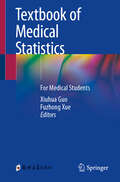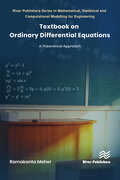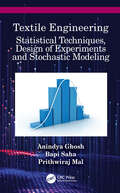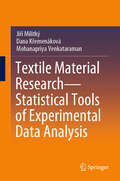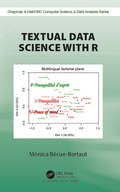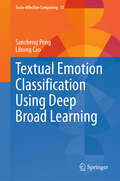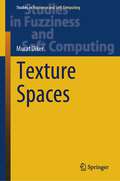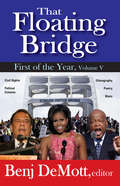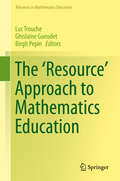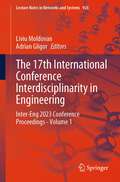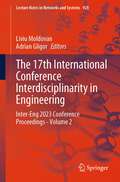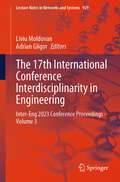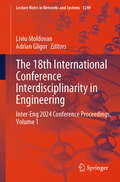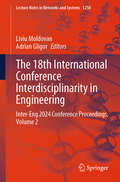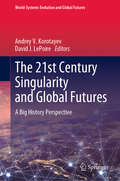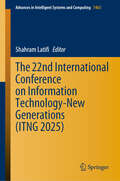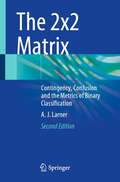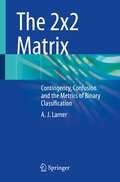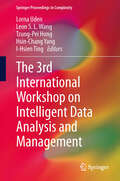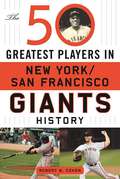- Table View
- List View
Textbook of Medical Statistics: For Medical Students
by Xiuhua Guo Fuzhong XueThis book introduces basic concepts, principle, and methods of medical statistics systematically and practically, especially in the statistical design of the experiment in terms of the specific problems, adequate use of statistical methods based on actual data and the reasonable explanation for statistical results.This textbook combines statistical methods with the common application of SPSS software, which is flexible, convenient, and user-friendly; thus, students can focus on the deep understanding of statistics.The authors emphasize the application and generalization of statistical methods, and combine these methods with the modern statistical theory, such as sequential contingency table and multivariate statistical modelling, etc.This book is a useful textbook for graduate and undergraduate students in medical schools, including MBBS (Bachelor of Medicine and Bachelor of Surgery) student.
Textbook on Ordinary Differential Equations: A Theoretical Approach
by Ramakanta MeherMany scientific and real-world problems that occur in science, engineering, and medicine can be represented in differential equations. There is a vital role for differential equations in studying the behavior of different types of real-world problems. Thus, it becomes crucial to know the existence and uniqueness properties of differential equations and various methods of finding differential equation solutions in explicit form. It is also essential to know different kinds of differential equations in terms of eigenvalues, termed eigenvalue problems, and some special functions used in finding the solution to differential equations. The study of nonlinear problems also plays a significant role in different real-world situations. There is a necessity to know the behavior of solutions of nonlinear differential equations. Still, there are very few forms of differential equations whose solution can be found in explicit form. For the differential equations whose solutions cannot be found in explicit form, one has to study the properties of solutions of the given differential equation to guess an approximate solution of it. This book aims to introduce all the necessary topics of differential equations in one book so that laymen can easily understand the subject and apply it in their research areas. The novel approach used in this book is the introduction of different analytical methods for finding the solution of differential equations with sufficient theorems, corollaries, and examples, and the geometrical interpretations in each topic. This textbook is intended to study the theory and methods of finding the explicit solutions to differential equations, wherever possible, and in the absence of finding explicit solutions, it is intended to study the properties of solutions to the given differential equations. This book is based on syllabi of the theory of differential equations prescribed for postgraduate students of mathematics and applied mathematics in different institutions and universities of India and abroad. This book will be helpful for competitive examinations as well.
Textile Engineering: Statistical Techniques, Design of Experiments and Stochastic Modeling
by Anindya Ghosh Prithwiraj Mal Bapi SahaFocusing on the importance of the application of statistical techniques, this book covers the design of experiments and stochastic modeling in textile engineering. Textile Engineering: Statistical Techniques, Design of Experiments and Stochastic Modeling focuses on the analysis and interpretation of textile data for improving the quality of textile processes and products using various statistical techniques. FEATURES Explores probability, random variables, probability distribution, estimation, significance test, ANOVA, acceptance sampling, control chart, regression and correlation, design of experiments and stochastic modeling pertaining to textiles Presents step-by-step mathematical derivations Includes MATLAB® codes for solving various numerical problems Consists of case studies, practical examples and homework problems in each chapter This book is aimed at graduate students, researchers and professionals in textile engineering, textile clothing, textile management and industrial engineering. This book is equally useful for learners and practitioners in other science and technological domains.
Textile Material Research—Statistical Tools of Experimental Data Analysis
by Mohanapriya Venkataraman Jiří Militký Dana KřemenákováThis book presents the effective combination of mathematical statistics, general metrology, and textile metrology to allow data analysis with regard to the evaluation of parameters of fibrous structures. Specialists working in material sciences, where fibrous structures are used, comprehensively understand the specifics of the fabric evaluation and manage in the context of rational use of selected mathematical and statistical methods. In this book, selected methods that are advantageous for data analysis, regardless of whether they are elementary or advanced are presented. The so-called computer-intensive methods are used in many situations when classical statistics is unable to offer a solution, or the solution is too complicated.
Textual Data Science with R (Chapman & Hall/CRC Computer Science & Data Analysis)
by Mónica Bécue-BertautTextual Statistics with R comprehensively covers the main multidimensional methods in textual statistics supported by a specially-written package in R. Methods discussed include correspondence analysis, clustering, and multiple factor analysis for contigency tables. Each method is illuminated by applications. The book is aimed at researchers and students in statistics, social sciences, hiistory, literature and linguistics. The book will be of interest to anyone from practitioners needing to extract information from texts to students in the field of massive data, where the ability to process textual data is becoming essential.
Textual Emotion Classification Using Deep Broad Learning (Socio-Affective Computing #11)
by Sancheng Peng Lihong CaoIn this book, the authors systematically and comprehensively discuss textual emotion classification by using deep broad learning. Since broad learning possesses certain advantages such as simple network structure, short training time and strong generalization ability, it is a new and promising framework for textual emotion classification in artificial intelligence. As a result, how to combine deep and broad learning has become a new trend of textual emotion classification, a booming topic in both academia and industry. For a better understanding, both quantitative and qualitative results are present in figures, tables, or other suitable formats to give the readers the broad picture of this topic along with unique insights of common sense and technical details, and to pave a solid ground for their forthcoming research or industry applications. In a progressive manner, the readers will gain exclusive knowledge in textual emotion classification using deep broad learning and be inspired to further investigate this underexplored domain. With no other similar book existing in the literature, the authors aim to make the book self-contained for newcomers, only a few prerequisites being expected from the readers. The book is meant as a reference for senior undergraduates, postgraduates, scientists and researchers interested to have a quick idea of the foundations and research progress of security and privacy in federated learning, and it can equally well be used as a textbook by lecturers, tutors, and undergraduates.
Texture Spaces (Studies in Fuzziness and Soft Computing #411)
by Murat DikerThis book provides a complete framework for the fundamental concepts and results of texture spaces and its applications. The principal aim is to present a comprehensive arguments due to connections among the textures, fuzzy sets and rough sets. In this context, direlations, fuzzy direlations and fuzzy relations constitute a bridge for the remarkable observations on rough set theory. In a more general setting, the approximation operators are also inspected for fuzzy rough set models with two domains of discourse. Since the book is self-contained and reader-friendly, the respected researchers may utilize this source for further investigations of the necessary results for their studies on rough set theory using textures. Therefore, prospective readers are not only mathematicians who interest in purely mathematical theories related to textures, but also engineers of information sciences who need more information for their interdisciplinary studies with respect to rough sets and fuzzy sets.
That Floating Bridge
by Benj DeMottAlive to history in the making (and the weight of the past) this volume examines Obama's presidency and Lyndon Johnson's, the killing of Trayvon Martin and the death of Andrew Breitbart, Occupy Wall Street and "America Beyond Capitalism." It presents essays, poems, and plays that speak to our times and challenge the liberal imagination. The title, That Floating Bridge, evokes Representative John Lewis' line "Obama is what comes at the end of that bridge in Selma" as it quotes a track on Gregg Allman's Low Country Blues, which Scott Spencer lauds here in a review for the Ages.That Floating Bridge's peerless range of contributors includes Amiri Baraka, Gar Alperovitz, Bernard Avishai, Uri Avnery, Bill Ayers, Paul Berman, John Chernoff, Mark Dudzic, Carmelita Estrellita, Henry Farrell, Fr. Rick Frechette, Donna Gaines, David Golding, Eugene Goodheart, Lawrence Goodwyn, Lisa Guenther, Alec Harrington, Malcolm Harris, Casey Hayden, Christopher Hayes, Patterson Hood, Roxane Johnson, Ben Kessler, Bob Levin, Philip Levine, Bongani Madondo, Greil Marcus, Scott McLemee, Judy Oppenheimer, Jedediah Purdy, Nick Salvatore, Aram Saroyan, Tom Smucker, Fredric Smoler, Violet Socks, A. B. Spellman, Scott Spencer, Richard Torres, Jesmyn Ward, and Pablo Yglesias.An account of how Franz Boas "did more to combat race prejudice than any other person" anchorsone section, but the volume also addresses devolutions of "diversity" linked with careerism in the art world and academe. An un-scholastic section titled "Criticism of Life"celebrates older and younger critics/poets. Songs are key to this volume's good times. Music writing ranging from Eddie Hinton's Very Extremely Dangerous to Berlioz's Romeo and Juliet enhances the pleasures of this text.
The 'Resource' Approach to Mathematics Education (Advances in Mathematics Education)
by Ghislaine Gueudet Birgit Pepin Luc TroucheThis edited volume will help educators better analyze methodological and practical tools designed to aid classroom instruction. It features papers that explore the need to create a system in order to fully meet the uncertainties and developments of modern educational phenomena. These have emerged due to the abundance of digital resources and new forms of collective work.The collected papers offer new perspectives to a rising field of research known as the Documentational Approach to Didactics. This framework was first created by the editors of this book. It seeks to develop a deeper understanding of mathematics teaching expertise. Readers will gain insight into how to meet the theoretical questions brought about by digitalization. These include: how to analyze teachers’ work when they prepare for their teaching, how to conceptualize the relationships between individual and collective work, and how to follow the related processes over the long term.The contributors also provide a comparative view in terms of contrasting selected phenomena across different educational cultures and education systems. For instance, they consider how differences in curriculum resources are available to teachers and how teachers make use of them to shape instruction. Coverage also considers the extent to which teachers make use of additional material, particularly those available through the global marketplace on the Internet. This book builds on works from the Re(s)sources 2018 Conference, Understanding teachers’ work through their interactions with resources for teaching, held in Lyon, France.
The 100 Hats of the Cat in the Hat A Celebration of the 100th Day of School: A Celebration of the 100th Day of School (The Cat in the Hat's Learning Library)
by Tish RabeLaugh and learn with fun facts about counting, adding, and dividing with 100—all told in Dr. Seuss&’s beloved rhyming style and starring the Cat in the Hat!&“Get ready to count, multiply, and divide. We don&’t want to be late, so jump in and let&’s ride!&”The Cat in the Hat&’s Learning Library series combines beloved characters, engaging rhymes, and Seussian illustrations to introduce children to non-fiction topics from the real world! When the Cat in the Hat visits on the 100th day of school, he teaches kids how to: add and subtractskip countmultiply and divide in groups of 2, 5, 10, and 25and much more!Perfect for story time and for the youngest readers, The 100 Hats of the Cat in the Hat: A Celebration of the 100th Day of School also includes an index, glossary, and suggestions for further learning.Look for more books in the Cat in the Hat&’s Learning Library series!High? Low? Where Did It Go? All About Animal CamouflageIs a Camel a Mammal? All About MammalsA Great Day for Pup: All About Wild BabiesWould You Rather Be a Pollywog? All About Pond LifeHappy Pi Day to You! All About Measuring CirclesI Can Name 50 Trees Today! All About TreesFine Feathered Friends: All About BirdsMy, Oh My--A Butterfly! All About ButterfliesOh Say Can You Seed? All About Flowering PlantsInside Your Outside! All About the Human BodyIce is Nice! All About the North and South Poles
The 14 Fibs of Gregory K.
by Greg PincusFailing math but great at writing, Gregory finds the poetry (and humor) in what's hard.Gregory K is the middle child in a family of mathematical geniuses. But if he claimed to love math? Well, he'd be fibbing. What he really wants most is to go to Author Camp. But to get his parents' permission he's going to have to pass his math class, which has a probability of 0. THAT much he can understand! To make matters worse, he's been playing fast and loose with the truth: "I LOVE math" he tells his parents. "I've entered a citywide math contest!" he tells his teacher. "We're going to author camp!" he tells his best friend, Kelly. And now, somehow, he's going to have to make good on his promises.Hilariously it's the "Fibonacci Sequence" -- a famous mathematical formula! -- that comes to the rescue, inspiring Gregory to create a whole new form of poem: the Fib! Maybe Fibs will save the day, and help Gregory find his way back to the truth. For every kid who equates math with torture but wants his own way to shine, here's a novel that is way more than the sum of its parts.
The 17th International Conference Interdisciplinarity in Engineering: Inter-Eng 2023 Conference Proceedings - Volume 1 (Lecture Notes in Networks and Systems #926)
by Liviu Moldovan Adrian GligorThis book contains research papers that were accepted for presentation at the 17th International Conference on Interdisciplinarity in Engineering—INTER-ENG 2023, which was held on 5–6 October 2023, in the city of Târgu Mureș, Romania. The general scope of the conference “Towards transition for a more competitive European industry in a smart, safe and sustainable future” is proposing a new approach related to the development of a new generation of smart factories grounded on the manufacturing and assembly process digitalization. It is related to advance manufacturing technology, lean manufacturing, sustainable manufacturing, additive manufacturing, manufacturing tools and equipment. It is a leading international professional and scientific forum of great interest for engineers and scientists who can read in this book research works contributions and recent developments as well as current practices in advanced fields of engineering.
The 17th International Conference Interdisciplinarity in Engineering: Inter-Eng 2023 Conference Proceedings - Volume 2 (Lecture Notes in Networks and Systems #928)
by Liviu Moldovan Adrian GligorThis book contains research papers that were accepted for presentation at the 17th International Conference on Interdisciplinarity in Engineering—INTER-ENG 2023, which was held on 5–6 October 2023, in the city of Târgu Mureș, Romania. The general scope of the conference “Towards transition for a more competitive European industry in a smart, safe and sustainable future” is proposing a new approach related to the development of a new generation of smart factories grounded on the manufacturing and assembly process digitalization. It is related to advance manufacturing technology, lean manufacturing, sustainable manufacturing, additive manufacturing, manufacturing tools and equipment. It is a leading international professional and scientific forum of great interest for engineers and scientists who can read in this book research works contributions and recent developments as well as current practices in advanced fields of engineering.
The 17th International Conference Interdisciplinarity in Engineering: Inter-Eng 2023 Conference Proceedings - Volume 3 (Lecture Notes in Networks and Systems #929)
by Liviu Moldovan Adrian GligorThis book contains research papers that were accepted for presentation at the 17th International Conference on Interdisciplinarity in Engineering—INTER-ENG 2023, which was held on 5–6 October 2023, in the city of Târgu Mureș, Romania. The general scope of the conference “Towards transition for a more competitive European industry in a smart, safe and sustainable future” is proposing a new approach related to the development of a new generation of smart factories grounded on the manufacturing and assembly process digitalization. It is related to advance manufacturing technology, lean manufacturing, sustainable manufacturing, additive manufacturing, manufacturing tools and equipment. It is a leading international professional and scientific forum of great interest for engineers and scientists who can read in this book research works contributions and recent developments as well as current practices in advanced fields of engineering.
The 18th International Conference Interdisciplinarity in Engineering: Inter-Eng 2024 Conference Proceedings, Volume 1 (Lecture Notes in Networks and Systems #1249)
by Liviu Moldovan Adrian GligorThis book contains research papers that were accepted for presentation at the 18th International Conference on Interdisciplinarity in Engineering—INTER-ENG 2024, which was held on 3–4 October 2024, in the city of Targu Mures, Romania. The general scope of the conference “An effective digital-green transition for a more competitive European industry” is proposing a new approach related to the development of a new generation of smart factories grounded on the manufacturing and assembly process digitalization. It is related to advance manufacturing technology, lean manufacturing, sustainable manufacturing, additive manufacturing, manufacturing tools and equipment. It is a leading international professional and scientific forum of great interest for engineers and scientists who can read in this book research works contributions and recent developments as well as current practices in advanced fields of engineering.
The 18th International Conference Interdisciplinarity in Engineering: Inter-Eng 2024 Conference Proceedings, Volume 2 (Lecture Notes in Networks and Systems #1250)
by Liviu Moldovan Adrian GligorThis book contains research papers that were accepted for presentation at the 18th International Conference on Interdisciplinarity in Engineering—INTER-ENG 2024, which was held on 3–4 October 2024, in the city of Targu Mures, Romania. The general scope of the conference “An effective digital-green transition for a more competitive European industry” is proposing a new approach related to the development of a new generation of smart factories grounded on the manufacturing and assembly process digitalization. It is related to advance manufacturing technology, lean manufacturing, sustainable manufacturing, additive manufacturing, manufacturing tools and equipment. It is a leading international professional and scientific forum of great interest for engineers and scientists who can read in this book research works contributions and recent developments as well as current practices in advanced fields of engineering.
The 1998 Yankees: The Inside Story of the Greatest Baseball Team Ever
by Jack Curry"The 1998 Yankees were a perfectly constructed team. Jack Curry does an amazing job of telling the tales of that phenomenal group." —David ConeDiscover the inside story of the Yankees' unprecedented talent with this gripping account from a reporter who was there for the team's 125 wins. The visiting clubhouse in San Diego was soggy, sweaty and sticky after the 1998 Yankees swept the Padres in four games and celebrated winning their 24th World Series title. The players raised bottles of Champagne, sprayed the bubbly on each other and reveled in a baseball season that might have been more memorable than any in history. Jack Curry was part of that unforgettable scene as a reporter, navigating around the clubhouse to ask the same, pertinent question. After winning an unprecedented 125 games and pummeling teams along the way, were these Yankees, the Yankees of Jeter, Mariano, Posada, Pettitte, Bernie, O&’Neill, Tino and so many other vital players, the best team ever? &“Right now, you would have to call them the best team ever,&” said owner George Steinbrenner. Twenty five years later, Curry revisits that season to discuss how that team was built and why the Yankees were such a talented, refreshing and successful club. This book includes new interviews with more than 25 players, coaches and executives, who revealed some behind-the-stories about the magical journey and who also discussed the depth of this historic squad. &“From the first man to the 25th man on the roster, I don&’t think there&’s a team that had more talent and a team whose players knew their roles as well as our players did,&” said pitcher David Cone. &“If you&’re using that as a barometer for the best team of all-time, then I think you can call us the best team of all-time.&” During that wondrous season, Don Zimmer, a Yankee coach and a baseball lifer who began his career with the Brooklyn Dodgers in 1954, told associates there would never be another team like the 1998 Yankees. Zimmer was right. Twenty five years later, Curry describes how and why that Yankee team could be the best ever.
The 21st Century Singularity and Global Futures: A Big History Perspective (World-Systems Evolution and Global Futures)
by Andrey V. Korotayev David J. LePoireThis book introduces a 'Big History' perspective to understand the acceleration of social, technological and economic trends towards a near-term singularity, marking a radical turning point in the evolution of our planet. It traces the emergence of accelerating innovation rates through global history and highlights major historical transformations throughout the evolution of life, humans, and civilization. The authors pursue an interdisciplinary approach, also drawing on concepts from physics and evolutionary biology, to offer potential models of the underlying mechanisms driving this acceleration, along with potential clues on how it might progress. The contributions gathered here are divided into five parts, the first of which studies historical mega-trends in relation to a variety of aspects including technology, population, energy, and information. The second part is dedicated to a variety of models that can help understand the potential mechanisms, and support extrapolation. In turn, the third part explores various potential future scenarios, along with the paths and decisions that are required. The fourth part presents philosophical perspectives on the potential deeper meaning and implications of the trend towards singularity, while the fifth and last part discusses the implications of the Search for Extraterrestrial Intelligence (SETI). Given its scope, the book will appeal to scholars from various disciplines interested in historical trends, technological change and evolutionary processes.
The 22nd International Conference on Information Technology-New Generations (Advances in Intelligent Systems and Computing #1463)
by Shahram LatifiThis book covers technical contributions that have been submitted, reviewed and presented at the 22nd annual event of International conference on Information Technology: New Generations (ITNG) The applications of advanced information technology to such domains as astronomy, biology, education, geosciences, security and health care are among topics of relevance to ITNG. Visionary ideas, theoretical and experimental results, as well as prototypes, designs, and tools that help the information readily flow to the user are of special interest. Machine Learning, Robotics, High Performance Computing, and Innovative Methods of Computing are examples of related topics.
The 2x2 Matrix: Contingency, Confusion and the Metrics of Binary Classification
by A. J. LarnerThis book describes, extends, and illustrates the metrics of binary classification through worked examples.Worked examples based on pragmatic test accuracy study data are used in chapters to illustrate relevance to day-to-day clinical practice. Readers will gain an understanding of sensitivity and specificity and predictive values along with many other parameters.The contents are highly structured, and the use of worked examples facilitates understanding and interpretation.This book is a resource for clinicians in any discipline who are involved in the performance or assessment of test accuracy studies and professionals in the disciplines of machine learning or informatics wishing to gain insight into clinical applications of 2x2 tables.
The 2x2 Matrix: Contingency, Confusion and the Metrics of Binary Classification
by A.J. LarnerThis book presents and discusses the numerous measures of test performance that can be derived from 2x2 tables. Worked examples based on pragmatic test accuracy study data are used in chapters to illustrate relevance to day-to-day clinical practice. Readers will gain a good understanding of sensitivity and specificity and predictive values along with many other parameters.The contents are highly structured and the use of worked examples facilitates understanding and interpretation. This book is a resource for clinicians in any discipline who are involved in the performance or assessment of test accuracy studies, and professionals in the disciplines of machine learning or informatics wishing to gain insight into clinical applications of 2x2 tables.
The 3rd International Workshop on Intelligent Data Analysis and Management
by Lorna Uden I-Hsien Ting Hsin-Chang Yang Leon S.L. Wang Tzung-Pei HongThese papers on Intelligent Data Analysis and Management (IDAM) examine issues related to the research and applications of Artificial Intelligence techniques in data analysis and management across a variety of disciplines. The papers derive from the 2013 IDAM conference in Kaohsiung ,Taiwan. It is an interdisciplinary research field involving academic researchers in information technologies, computer science, public policy, bioinformatics, medical informatics, and social and behavior studies, etc. The techniques studied include (but are not limited to): data visualization, data pre-processing, data engineering, database mining techniques, tools and applications, evolutionary algorithms, machine learning, neural nets, fuzzy logic, statistical pattern recognition, knowledge filtering, and post-processing, etc.
The 50 Greatest Players in San Francisco/New York Giants History
by Robert W. CohenThe 50 Greatest Players in San Francisco/New York Giants History examines the careers of the 50 men who made the greatest impact on one of the National League’s most iconic and successful franchises. Using as measuring sticks the degree to which they impacted the fortunes of the team, the extent to which they added to the Giant legacy of excellence, and the levels of statistical compilation and overall dominance they attained while wearing a Giants uniform, Cohen ranks, from 1 to 50, the top 50 players in team history.Quotes from opposing players and former teammates are provided along the way, as are summaries of each player’s greatest season, most memorable performances, and most notable achievements.All the great Giants are here, from Willie Mays to Juan Marichal to Bobby and Barry Bonds to Buster Posey. Robert W. Cohen ranks the best of the best in The 50 Greatest Players in San Francisco/New York Giants History.
The A-Z of Primary Maths (John Catt A-Z series)
by Kate FroodThe A-Z of Primary Maths is a compendium of great ideas for teaching mathematics, organised around the 26 letters of the English alphabet.'Maths foundations must be built in our primary schools. We need to create space for children to play with numbers, to explore patterns, to solve problems, and to laugh and chat in maths lessons. It's this start that will build a lifelong love of and confidence in maths' - Kate Frood.
